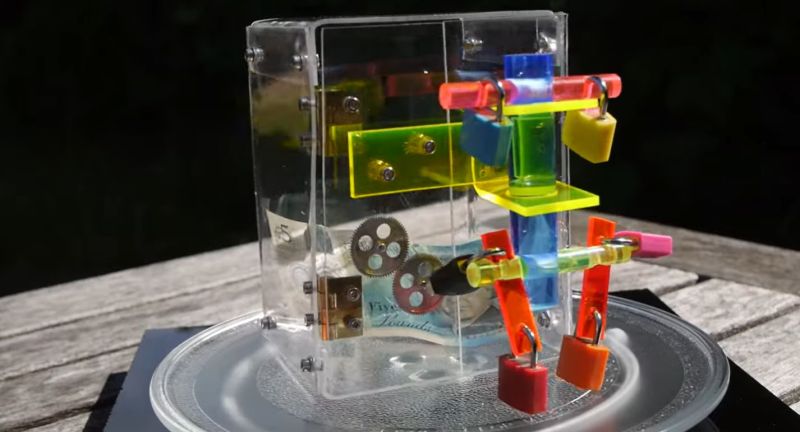Brunnian links are a type of nontrivial link – or knot – where multiple linked loops become unlinked if a single loop is cut or removed. Beyond ‘fun’ disentanglement toys and a tantalizing subject of academic papers on knot theory, it can also be used for practical applications, as demonstrated by [Anthony Francis-Jones] in a recent video. In it we get a safe that is locked with multiple padlocks, each of which can unlock and open the safe by itself.
This type of locked enclosure is quite commonly used in military and other applications where you do not want to give the same key to each person in a group, yet still want to give each person full access. After taking us through the basics of Brunnian links, including Borromean rings, we are introduced to the design behind the safe with its six padlocks.
As a demonstration piece it uses cheap luggage padlocks and Perspex (acrylic) rods and sheets to give a vibrant and transparent view of its workings. During the assembly it becomes quite apparent how it works, with each padlock controlling one direction of motion of a piece, each of which can be used to disassemble the entire locking mechanism and open the safe.
Brunnian links are also found in the braids often made by children out of elastic bands, which together with this safe can be used to get children hooked on Brunnian links and general knot theory.















What a good lad, I was impressed when he took the time to put it back together – shows that he wanted to properly understand the linkage.
“it can also be used for practical applications, as demonstrated by [Anthony Francis-Jones] in a recent video. In it we get a safe that is locked with multiple padlocks, each of which can unlock and open the safe by itself.”
As someone who shares access to gated sites with multiple agencies, we’ve always just used a padlock chain. Much simplier to maintain.
Way too complicated and it gets exponentially more complicated if you need to add more locks. Instead, just put any number of padlocks in a linked loop, and run that loop through the hasp. Unlock any single lock, and pull the chain of locks out of the hasp.
while that is topologically (?) the easier answer, the solution shown can (was not, but can) be made with zero wobble, and a definite position of the locks while the ever-lengthening chain will at some point be quite the hassle, dangling around and an ever-changing position of your own lock. That said, as soon as the situation is bring-your-own-lock, and/or the number of participants is unknown, the chain has some serious ease-of-use bonus points.
Keypad blows them both out of the water.
Exactly. I often visit shared remote radio repeater sites where there are up to a dozen padlocks all chained in series for different contractors and asset owners.
This sort of contraption would be a nightmare to implement in comparison.
A benefit of his implementation over the chain is that someone could mistakenly or purposefully relock chain to chain and cut everyone else’s access, while with his there’s only one place to put your lock, the spot from where it just came.